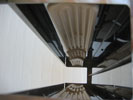IR heating in food processing
August 2009
Temperature Measurement

Infrared heating is gaining momentum in food processing because it is fast, energy efficient, contact-free and uniform. It is successfully used in drying, roasting, baking and sterilisation applications, with optimum results sometimes obtained from a combination of convection and IR heating.
Food is primarily heated to enhance taste and to extend shelf life. IR heating is ideal since the radiation is readily absorbed by organic substances and generates heat. Heat transfer is fast and can be achieved over some distance with insignificant losses. The wavelength of IR emission can be varied to achieve different effects: penetration, colour, crust, etc. IR heaters are broadly classified as shortwave (0,78–1,4 micron), medium wave (1,5–3,0 micron) and long wave (3,0–6 micron).
The effect of wavelength
Different food components absorb IR energy better at different wavelengths. Choosing a heater of the appropriate wavelength allows users to selectively heat the required food component. Shortwave IR penetrates deeper whereas the longer wavelengths have a greater effect on surface layers. Water, sugars and proteins absorb infrared heat best at wavelengths between 2,5 and 3,3 micron – medium to long wave IR.
Typical applications include the following:
Drying and dehydration
A combination of IR heating and air convection offers better results than air drying alone. Similar improvements can be obtained by adding IR heating to freeze drying processes.
Drying of fruit and vegetables using this combination has resulted in reduced drying times, improved energy efficiency, reduced air-flow requirements, superior product quality and lower overall cost.
Broiling
Some shellfish are irradiated aggressively with shortwave IR to open them. Subsequently they are broiled in the shell with long wave IR, preserving the aroma and texture. Good results are also obtained when heating potatoes, meat products and fish. Depending on the intensity and wavelength of the IR various surface effects like crusts can be formed.
Roasting
Nuts, cocoa beans and similar products are roasted effectively and fast with IR with superior effects on the outer layers. Very fast throughput can also be achieved when heating pre-baked pizzas on a conveyor system.
Sterilisation
IR heating is used to destroy enzymes and micro-organisms such as spores, yeast and bacteria. A typical example is heating the exposed layer of foods in glass or cans prior to sealing of the container.
unitemp designs and manufactures infrared heating arrays, air heating systems and control panels. Drawing on 30 years’ experience, the company has implemented heating solutions for most of the applications mentioned above.
Further reading:
New temperature transmitters with Profibus connectivity
Temperature Measurement
Siemens is enhancing its temperature measuring device portfolio with the transmitter duo, Sitrans TH420 PA and Sitrans TF420 PA. Both devices feature Profibus connectivity, advanced safety functions and expedited commissioning all in one unit.
Read more...
Enhancing industrial efficiency through advanced temperature control
Iritron
Temperature Measurement
Iritron has been offering modular smart thyristor drives to the local and international mining, minerals and metals market, including the latest new leading innovations in temperature control technology. These drives combined with advanced proportional-integral-derivative (PID) control will change the way large industries manage their heating processes, reducing costs and extending equipment lifespan.
Read more...
Non-contact infrared thermometer
Temperature Measurement
AMETEK LAND has developed a new non-contact infrared thermometer for precise measurement and control during deposition processes in optical fibre manufacturing.
Read more...
High-precision fill quantity control in food supplement production
Temperature Measurement
Vital Products was looking for a precise and efficient solution to check the weight and ensure the completeness of its products. Minebea Intec, a specialist in industrial weighing and inspection technologies, was able to provide a solution.
Read more...
The critical role of temperature measurement in flame hardening
Instrotech
Temperature Measurement
Flame hardening is a heat treatment process widely used on parts made from mild steels, alloy steels, medium carbon steels and cast iron. Accurate temperature measurement is not just important, but critical for the success of flame hardening.
Read more...
Noncontact infrared temperature control in aluminium rolling process
Instrotech
Temperature Measurement
The aluminium rolling process is critical to the aluminium manufacturing industry, where precise temperature measurement is essential for ensuring high-quality product output and protecting equipment. The Optris long-wavelength camera can accurately measure strip temperatures in cold rolling and coiling applications.
Read more...
Where simplicity meets reliability
Endress+Hauser South Africa
Temperature Measurement
The new iTEMP TMT31 temperature transmitter from Endress+Hauser combines simplified selection, ordering, installation and operation with the highest reliability and long-term stability in one product.
Read more...
Automating car window defrosters
Temperature Measurement
Window defrosters are vital features in vehicles, particularly in colder climates. The automotive manufacturer seeks an efficient solution to quickly and precisely measure the temperature of the windows, ensuring that the connections, installed cables and wires work correctly and have no defects before the vehicle’s final release.
Read more...
The impact of thermal imaging in steam methane reformers
Temperature Measurement
As global demand for hydrogen, ammonia and fertilisers increases, LAND is empowering steam methane reformer operators to unlock efficiency gains at existing plants to meet ambitious production targets while also safely decarbonising.
Read more...
Proven indicators monitored in three dimensions
ifm - South Africa
Temperature Measurement
The VVB30x continuously detects vibrations in three measurement axes and uses them to calculate proven indicators for evaluating machine condition.
Read more...


